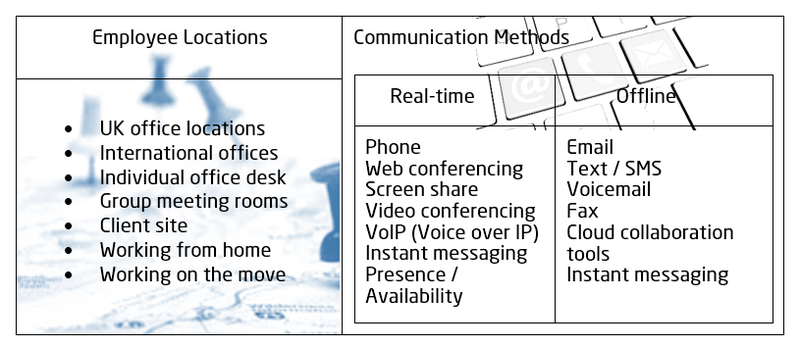Unified Communications aims to achieve maximum efficiency in communications, and data/information/resource sharing, with a tailored, user-based workflow, specific to each individual and their needs.
To put this in context of the modern workforce, consider the following. At any given time a business may have people in company offices (around the country and/or internationally), group meetings, people working from home, people on the move, people working on project sites, people visiting clients, and staff wanting to communicate with clients and third party suppliers.

Each one of those people has an ever increasing array of potential communication methods, both real-time and off-line; phone, email, instant messaging, web conferencing and screen share, videoconferencing, VoIP, voicemail, SMS, fax..

Ideally a company of this nature needs all its employees be able to communicate with one another at in the most appropriate manner and even use different types of communication devices and softwares within the same conversation, with ease. What can often prevent this in reality is the integration and compatibility issues that can arise when using multiple standalone communication devices. These disparate communication channels need to integrate seamlessly to maximise the overall efficiency of the business.
UC should integrate with your work environment, the programs you use, and the organisation tools that you currently rely on, providing return on investment (ROI) through efficiency saving.
Of course the audio and video quality must be optimised, but perhaps it’s relevant to your business to also offer your staff the benefits of more advanced features of a unified communications infrastructure, such as an option for sharing live annotations to all session participants, or recording the whole session’s audio and video, or distributing copies of all the annotated presentations to the participants as soon as the session has finished.
UC is scalable for the required level of complexity, and so can suit businesses of any size. The underlying concepts and end goals remain the same, with the power to streamline. Whilst UC, correctly implemented, has big implications for large multi-national companies in terms of man hours saved, deadlines met, and cost reduction, it has equally significant implications to smaller single premises companies as well. For example, if your five key members of your team need to be able to video conference, audio conference and teamwork via touch-screen devices whilst some of them are calling in via a mobile phone, others are in the office, and some are working from a desktop setup from home, UC will bring the team together in hassle-free collaboration.
Two significant growth areas for UC are:
- High Definition video communications
- Integration of smartphones and tablets as key tools for communication and workflow

When properly implemented a UC environment allows users to set up a conference to multiple users anywhere in the world, with various types of devices and location types: from a desk at home, in a boardroom setting, with people joining via the video capabilities of their Smartphone, and people who can only contribute by phone. It should give real-time information relating to the user’s ‘presence’ (i.e. their availability at the time) and it should allow users to simultaneously transfer data, images/video and presentation material from their computer. This shows how UC can quickly become a hugely useful and powerful tool.
UC represents the integration and unification of existing communication channels. It doesn’t have anything to do with the development of the communication technologies themselves. As a result the key technologies that drive unified communications are the ones that deliver the unification aspect.

The Unified Communication Interoperability Forum (UCIF), established in 2010, represented the initial collaboration of many of the world’s largest communication technologies vendors to drive the Unified Communications (UC) concept forward by way of developing open-standards and certifications for truly interoperable communications products and technologies. The UCIF since merged with the International Multimedia Telecommunications Consortium (IMTC) in 2014, another open-membership body, continuing the commitment by the leading players to develop protocols and technologies designed for more efficient real-time rich-media communications: a pivotal part of modern business operations.
UC is not a single product but rather a solution made up of a variety of communication tools and components.

UC aims to achieve maximum efficiency in communications, and data/information/resource sharing, with a tailored, user-based workflow, specific to each individual and their needs

